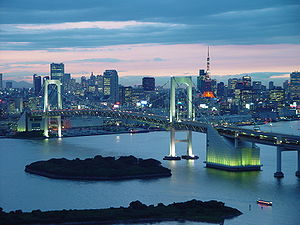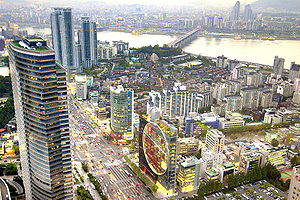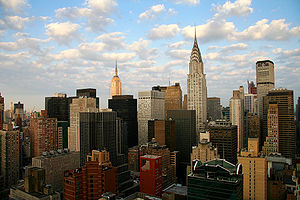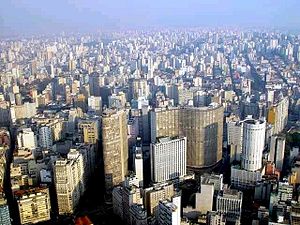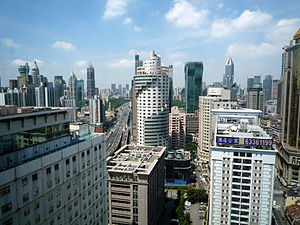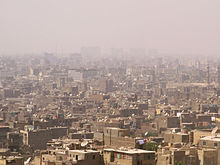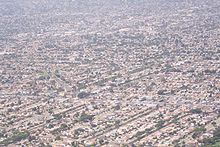- Megacity
-
This article is about the general category of conurbation. For other uses, see Mega City (disambiguation).
A megacity is usually defined as a metropolitan area with a total population in excess of 10 million people.[1] Some definitions also set a minimum level for population density (at least 2,000 persons/square km).[citation needed] A megacity can be a single metropolitan area or two or more metropolitan areas that converge. The terms conurbation, metropolis and metroplex are also applied to the latter. The terms "megapolis'" and megalopolis are sometimes used synonymously with megacity," though those terms denote a semi-continuous chain of large metropolitan cities.[citation needed]
As of 2011, there are 21 megacities in existence, which is the official figure despite the list below containing 27 megacities [2] – with conurbations such as Mumbai,[3] Tokyo, New York City, Dhaka, and Mexico City having populations in excess of 20 million inhabitants each. New Megacities like Johannesburg have population of over 10 million.
Contents
History
In 1800, only 3% of the world's population population lived in cities, a figure that has risen to 47% by the end of the twentieth century. In 1950, there were 83 cities with populations exceeding one million; by 2007, this number had risen to 468.[4] If the trend continues, the world's urban population will double every 38 years. The UN forecasts that today's urban population of 3.2 billion will rise to nearly 5 billion by 2030, when three out of five people will live in cities.[5]
This increase will be most dramatic on the least-urbanized continents, Asia and Africa. Surveys and projections indicate that all urban growth over the next 25 years will be in developing countries.[6] One billion people, almost one-seventh of the world's population, now live in shanty towns.[7] In many poor countries overpopulated slums exhibit high rates of disease due to unsanitary conditions, malnutrition, and lack of basic health care.[8] By 2030, over 2 billion people in the world will be living in slums.[9] Over 90% of the urban population of Ethiopia, Malawi and Uganda, three of the world's most rural countries, already live in slums.
By 2025, according to the Far Eastern Economic Review, Asia alone will have at least 10 megacities, including Mumbai, India (33 million), Shanghai, China (27 million), Karachi, Pakistan (26.5 million), Dhaka, Bangladesh (26 million) and Jakarta, Indonesia (24.9 million people).[10] Lagos, Nigeria has grown from 300,000 in 1950 to an estimated 12.5 million today, and the Nigerian government estimates that the city will have expanded to 25 million residents by 2015.[11]
Largest cities
Growth
For almost a thousand years, Rome was the largest, wealthiest, and most politically important city in Europe.[12] Its population passed a million people by the end of the 1st century BC.[13] Rome's population started dropping in 402 AD when Flavius Honorius moved the government to Ravenna and Rome's population declined to a mere 20,000 during the Early Middle Ages, reducing the sprawling city to groups of inhabited buildings interspersed among large areas of ruins and vegetation.
Baghdad was likely the largest city in the world from shortly after its foundation in 762 AD until the 930s, with some estimates putting its population at over one million.[14]
Chinese capital cities Chang'an, Kaifeng also experienced huge population booms during prosperous empires. According to the census in the year 742 recorded in the New Book of Tang, 362,921 families with 1,960,188 persons were counted in Jingzhao Fu (京兆府), the metropolitan area including small cities in the vicinity.[15]
The medieval settlement surrounding Angkor, the one-time capital of the Khmer Empire which flourished between the 9th and 15th centuries, could have supported a population of up to one million people.[16]
In 1950, New York City was the only urban area with a population of over 10 million.[17] Geographers had identified 25 such areas as of October 2005,[18] as compared with 19 megacities in 2004 and only nine in 1985. This increase has happened as the world's population moves towards the high (75–85%) urbanization levels of North America and Western Europe. The 1990 census marked the first time the majority of US citizens lived in cities with over 1 million inhabitants.
In the 2000s, the largest megacity is the Greater Tokyo Area. The population of this urban agglomeration includes areas such as Yokohama and Kawasaki, and is estimated to be between 35 and 36 million. This variation in estimates can be accounted for by different definitions of what the area encompasses. While the prefectures of Tokyo, Chiba, Kanagawa, and Saitama are commonly included in statistical information, the Japan Statistics Bureau only includes the area within 50 kilometers of the Tokyo Metropolitan Government Offices in Shinjuku, thus arriving at a smaller population estimate.[19][20] A characteristic issue of megacities is the difficulty in defining their outer limits and accurately estimating the populations.
Based on the population criteria, the world's 27 megacities are, in rank of population:
Rank Megacity Country Continent Population Annual Growth[citation needed] 1 Tokyo  Japan
JapanAsia 34,300,000 0.60% 2 Guangzhou  China
ChinaAsia 25,200,000 4.00% 3 Seoul  South Korea
South KoreaAsia 25,100,000 1.40% 4 Shanghai  China
ChinaAsia 24,800,000 2.20% 5 Delhi  India
IndiaAsia 23,300,000 4.60% 6 Mumbai  India
IndiaAsia 23,000,000 2.90% 7 Mexico City  Mexico
MexicoNorth America 22,900,000 2.00% 8 New York City  USA
USANorth America 22,000,000 0.30% 9 São Paulo  Brazil
BrazilSouth America 20,900,000 1.40% 10 Manila [21]  Philippines
PhilippinesAsia 20,300,000 2.50% 11 Jakarta  Indonesia
IndonesiaAsia 18,900,000 2.00% 12 Los Angeles  USA
USANorth America 18,100,000 1.10% 13 Karachi  Pakistan
PakistanAsia 17,000,000 4.90% 14 Osaka  Japan
JapanAsia 16,700,000 0.15% 15 Kolkata  India
IndiaAsia 16,600,000 2.00% 16 Cairo  Egypt
EgyptAfrica 15,300,000 2.60% 17 Buenos Aires  Argentina
ArgentinaSouth America 14,800,000 1.00% 18 Moscow  Russia
RussiaEurope 14,800,000 0.20% 19 Dhaka  Bangladesh
BangladeshAsia 14,000,000 4.10% 20 Beijing  China
ChinaAsia 13,900,000 2.70% 21 Tehran  Iran
IranAsia 13,100,000 2.60% 22 Istanbul  Turkey
TurkeyEurope & Asia 13,000,000 2.80% 23 London  United Kingdom
United KingdomEurope 12,500,000 0.70% 24 Rio de Janeiro  Brazil
BrazilSouth America 12,500,000 1.00% 25 Lagos  Nigeria
NigeriaAfrica 12,100,000 3.20% 26 Paris  France
FranceEurope 10,197,678 1.00% Source: Th. Brinkhoff: The Principal Agglomerations of the World, 2011-07-01
Another list defines megacities as urban agglomerations instead of metropolitan areas.[22] As of 2010, there are 25 megacities by this definition.
Challenges
Slums
According to the United Nations, the proportion of urban dwellers living in slums decreased from 47 percent to 37 percent in the developing world between 1990 and 2005.[23] However, due to rising population, the absolute number of slum dwellers is rising. The majority of these come from the fringes of urban margins, located in legal and illegal settlements with insufficient housing and sanitation. This has been caused by massive migration, both internal and transnational, into cities, which has caused growth rates of urban populations and spatial concentrations not seen before in history. These issues raise problems in the political, social, and economic arenas. Slum dwellers often have minimal or no access to education, healthcare, or the urban economy.
Homelessness
Megacities often have significant numbers of homeless people. The actual legal definition of homelessness varies from country to country, or among different entities or institutions in the same country or region.[24]
Traffic congestion
Traffic congestion is a condition on road networks that occurs as use increases, and is characterized by slower speeds, longer trip times, and increased vehicular queueing.
Urban sprawl
A flat land area in the greater Los Angeles area almost completely filled with houses, buildings, roads, and freeways. Areas constructed to capacity contribute to urban expansion.
Urban sprawl, also known as suburban sprawl, is a multifaceted concept, which includes the spreading outwards of a city and its suburbs to its outskirts to low-density, auto-dependent development on rural land, with associated design features that encourage car dependency.[25] As a result, some critics argue that sprawl has certain disadvantages, including, longer transport distances to work, high car dependence, inadequate facilities e.g.: health, cultural. etc. and higher per-person infrastructure costs. Discussions and debates about sprawl are often obfuscated by the ambiguity associated with the phrase. For example, some commentators measure sprawl only with the average number of residential units per acre in a given area. But others associate it with decentralization (spread of population without a well-defined center), discontinuity (leapfrog development), segregation of uses, etc.[citation needed]
Gentrification
Gentrification and urban gentrification denote the socio-cultural changes in an area resulting from wealthier people buying housing property in a less prosperous community.[26] Consequent to gentrification, the average income increases and average family size decreases in the community, which may result in the informal economic eviction of the lower-income residents, because of increased rents, house prices, and property taxes. This type of population change reduces industrial land use when it is redeveloped for commerce and housing. In addition, new businesses, catering to a more affluent base of consumers, tend to move into formerly blighted areas, further increasing the appeal to more affluent migrants and decreasing the accessibility to less wealthy natives.
Environmental problems
Air pollution
Air pollution is the introduction of chemicals, particulate matter, or biological materials that cause harm or discomfort to humans or other living organisms, or damages the natural environment, into the atmosphere. Many urban areas have significant problems with smog, a type of air pollution derived from vehicular emission from internal combustion engines and industrial fumes that react in the atmosphere with sunlight to form secondary pollutants that also combine with the primary emissions to form photochemical smog.
Smog is also caused by large amounts of coal burning, which creates a mixture of smoke and sulfur dioxide. World coal consumption was about 6,743,786,000 short tons in 2006[27] and is expected to increase 48% to 9.98 billion short tons by 2030.[28] China produced 2.38 billion tons in 2006. India produced about 447.3 million tons in 2006. 68.7% of China's electricity comes from coal. The USA consumes about 14% of the world total, using 90% of it for generation of electricity.[29]
In fiction
- Many of the following fictional cities were inspired by Fritz Lang's 1927 film, Metropolis and the influential depiction of Los Angeles in Ridley Scott's 1982 film, Blade Runner.
- Megacities are a common backdrop in dystopian science fiction, with examples such as the Sprawl in William Gibson's Neuromancer,[30] and Mega-City One, a megalopolis of over 400 million people across the east coast of the United States, in the Judge Dredd comic.[31] In Demolition Man a megacity called "San Angeles" was formed from the joining of Los Angeles, Santa Barbara, San Diego and the surrounding metropolitan regions following a massive earthquake in 2010.[32]
- Fictional planet-wide megacities (ecumenopoleis) include Trantor in Isaac Asimov's Foundation series of books and Coruscant in the Star Wars universe.[33] Other examples are 'City Europe' in David Wingrove's Chung Kuo series of books, Holy Terra and the hive cities of Necromunda in Warhammer 40,000 and Ravnica in the eponymous Magic: The Gathering expansion.
- The futuristic comic seriesTransmetropolitan is based in a megacity simply referred to as The City which seems to be an amalgamation of many cities along the East coast of America.
- The Fifth Element features a parody of New York City set in 2263. Buildings are so high that people use flying cars to get around and the ground level of the Earth is obscured by pollution.
- The 1973 film Soylent Green, based on Harry Harrison's novel Make Room, Make Room, depicted New York City in 2022 with a population of 40 million. It is not said how large the city is, but the main character does make the comment that a wanted criminal is "over the city line in Philadelphia" implying that it has sprawled that far.
- The sprawling metropolis featured in The Matrix series of films can be considered a megacity. It is based on Sydney, Chicago and Oakland, California. While the city is never referenced by name in the films, in the MMORPG The Matrix Online, the city itself is called the Mega City.
See also
Notes
- ^ "How Big Can Cities Get?" New Scientist Magazine, 17 June 2006, page 41.
- ^ "7 Billion, National Geographic Magazine". Accessed January 2011.
- ^ "Mumbai" - Type of Geographical entity. World-gazetteer.com. Accessed May 2010.
- ^ "Principal Agglomerations of the World". Citypopulation.de. http://www.citypopulation.de/World.html. Retrieved 2010-09-01.
- ^ "Megacities Of The Future". Forbes.com. 2007-06-11. http://www.forbes.com/2007/06/11/megacities-population-urbanization-biz-cx_21cities_ml_0611megacities.html. Retrieved 2010-09-01.
- ^ "Nigeria: Lagos, the mega-city of slums". Energypublisher.com. http://www.energypublisher.com/article.asp?id=5307. Retrieved 2010-09-01.
- ^ Whitehouse, David (2005-05-19). "Half of humanity set to go urban". BBC News. http://news.bbc.co.uk/2/hi/science/nature/4561183.stm. Retrieved 2010-09-01.
- ^ "Planet of Slums - The Third World’s Megacities". Blackcommentator.com. http://www.blackcommentator.com/88/88_reprint_planet_slums.html. Retrieved 2010-09-01.
- ^ "State of World Population 2007". Unfpa.org. http://www.unfpa.org/swp/2007/english/chapter_2/slums.html. Retrieved 2010-09-01.
- ^ May 20, 2006 (2006-05-20). "Planet of Slums by Mike Davis". Atimes.com. http://www.atimes.com/atimes/Front_Page/HE20Aa01.html. Retrieved 2010-09-01.
- ^ "Lagos, Nigeria facts". National Geographic. 2006-07-28. http://www3.nationalgeographic.com/places/cities/city_lagos.html. Retrieved 2010-09-01.
- ^ "Roman Empire Population". Unrv.com. http://www.unrv.com/empire/roman-population.php. Retrieved 2010-09-01.
- ^ "Population crises and cycles in history". Home.vicnet.net.au. http://home.vicnet.net.au/~ozideas/poprus.htm. Retrieved 2010-09-01.
- ^ "Largest Cities Through History". Geography.about.com. 2010-06-16. http://geography.about.com/library/weekly/aa011201a.htm. Retrieved 2010-09-01.
- ^ New Book of Tang, vol. 41 (Zhi vol. 27) Geography 1.
- ^ Metropolis: Angkor, the world's first mega-city, The Independent, August 15, 2007
- ^ Tertius Chandler, 1987, St. David's University Press. "Top 10 Cities of the Year 1950". Four Thousand Years of Urban Growth: An Historical Census. http://geography.about.com/library/weekly/aa011201g.htm. Retrieved 2007-03-24.
- ^ "Population statistics". Citypopulation.de. http://www.citypopulation.de/World.html. Retrieved 2010-09-01.
- ^ "Greater Tokyo population statistics". Stat.go.jp. 2008-10-01. http://www.stat.go.jp/english/data/handbook/c02cont.htm. Retrieved 2010-09-01.
- ^ "Tokyo metropolitan area population statistics". Citypopulation.de. http://www.citypopulation.de/World.html. Retrieved 2010-09-01.
- ^ When counting the country's population, the population in the city extends to the whole Metropolitan Area although it is an entry as a city only
- ^ http://www.demographia.com/db-megacity.pdf
- ^ "p. 26" (PDF). http://www.un.org/millenniumgoals/pdf/mdg2007.pdf. Retrieved 2010-09-01.
- ^ "Glossary defining homelessness". Homeless.org.au. http://www.homeless.org.au/glossary.htm. Retrieved 2010-09-01.
- ^ What is Sprawl?. SprawlCity.org. Retrieved on 2008-02-07.
- ^ Benjamin Grant (June 17, 2003). Urban gentrification is associated with movement "PBS Documentaries with a point of view: What is Gentrification?". Public Broadcasting Service. http://www.pbs.org/pov/flagwars/special_gentrification.php Urban gentrification is associated with movement.
- ^ World coal consupmption 1980-2006 October 2008 EIA statistics
- ^ EIA, World Energy Projections Plus (2009)
- ^ "U.S. Coal Supply and Demand". Eia.doe.gov. http://www.eia.doe.gov/cneaf/coal/page/special/feature.html. Retrieved 2010-09-01.
- ^ Sharp, Michael D. (2005). Popular Contemporary Writers. Marshall Cavendish. ISBN 0761476016.
- ^ Powell, Vincent (2005). The Legal Companion. Robson. p. 54. ISBN 1861058381.
- ^ Namu, Adilifu (2008). Black space: imagining race in science fiction film. University of Texas Press. ISBN 0292717458.
- ^ Westfahl, Gary (2005). The Greenwood encyclopedia of science fiction and fantasy: themes, works, and wonders, Volume 2. Greenwood Publishing Group. ISBN 0313329524.
References
- Soja, Edward W., "Postmetropolis, Critical Studies of Cities and Regions", Blackwell Publishing Ltd., 2000 (alk. paper, ISBN 1557180003; paperback, ISBN 1557180011)
External links
- United Nations Department of Economic and Social Affairs, Population Division
- e-Geopolis project Research Group, University Paris-Diderot
- Lagos la Vida Loca by Mariana van Zeller on Current TV Nov. 2007
- Megacities Task Force
- Maps of US Megacities from radicalcartography.net
- IEEE Spectrum report on "Engineering the Megacity"
- URBAN PLANET: Collective Identities, Governance and Empowerment in Megacities
World's twenty most populous metropolitan areas 6
 Jakarta
Jakarta
7 São Paulo
São Paulo
8 Delhi
Delhi
9 Keihanshin
Keihanshin
10 Shanghai
Shanghai16
 Cairo
Cairo
17 Buenos Aires
Buenos Aires
18 London
London
19 Beijing
Beijing
20 KarachiCategories:
KarachiCategories:- Urban studies and planning terminology
- Human habitats
- Population
Wikimedia Foundation. 2010.

